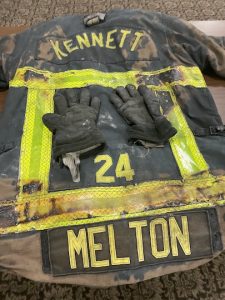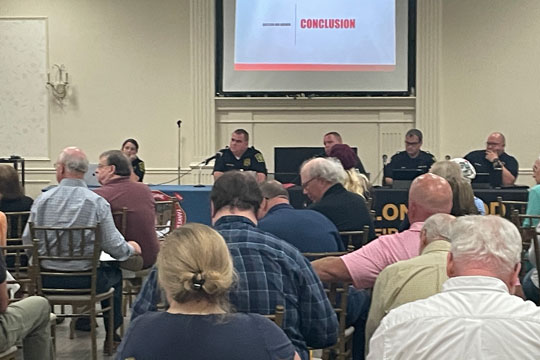There are two upcoming chances for area residents who want to know more about fire and EMS services and the associated costs to municipalities and taxpayers.
The Kennett Fire & EMS Regional Commission will hold a special meeting at noon Aug. 31 to discuss the 2024 budget. It will be in-person at the Pocopson Township building, 664 S. Wawaset Road, and is open to the public.
Last year, the borough of Kennett Square and the townships of Kennett, East Marlborough, Pennsbury, Pocopson, and Newlin faced a 30 percent increase in their annual payments to the commission. Other increases are expected in this and future years as the commission looks at replacing equipment and keeping stations staffed.
The commission will also hold the second of two town hall meetings on Thursday, Sept. 14 at 7 p.m. in the Red Clay Room in Kennett Square. That will address Kennett Borough’s vote earlier this year to leave the commission in 2024 and examine the impacts of that decision and how it could affect fire and EMS service to borough residents, according to Commission Chief A.J. McCarthy.
By law, McCarthy explained at an Aug. 24 town hall, municipalities are required to designate who will provide fire and EMS services to their residents. That is usually done each January during annual reorganization meetings when the municipalities approve resolutions naming those providers.
The August town hall provided the almost 60 people in attendance with an overview of the six-year-old commission and how the fire and EMS providers respond. It also dealt with the costs of offering these services to the community.
The town hall featured members of Longwood, Kennett, and Po-Mar-Lin fire companies, the regional EMS service, as well as township officials.

“The fire and EMS commission was founded in 2017, and the mission was to lessen the burden on the local government by providing inter-municipal collaboration and pooling of municipal resources and funds,” McCarthy said, adding that in 2019 Kennett Fire Company’s EMS service was shut down, and its volunteers and coverage area were combined with Longwood’s EMS.
“Before this, we were two separate operations and had to send two vehicles,” McCarthy added. “We both had costs to cover. By doing this – now everybody only gets one bill. It allows us to do even better billing analyses. We’re currently talking about a third truck that has to go in service to keep up with the call volume.”
While the Department of Health oversees the EMS services, there is no regulatory agency for the approximately 2,700 fire departments in Pennsylvania, according to McCarthy.
And while volunteers have been the backbone of fire companies throughout their history, the growth of suburbs, two-income families, and more have caused a sharp decline in the people who give up their free time to keep their communities safe, according to Kennett Fire Company Assistant Chief Rick Franks.
“We’re seeing an era where we could see the end of volunteers,” he said at the August town hall. “Previously households could be taken care of on one income. Now a lot of houses are two-income, leaving a lot less time to volunteer.”
He added that the standards to train to become firefighters and emergency medical technicians have gotten harder and require more time.
“You have about 400 hours of service to become a basic entry firefighter, which is a lot to ask of someone,” he said. “It’s hard to get someone to commit.”
Longwood Assistant EMS Chief Matt Eick said EMT training when he first began was 180 hours but has since grown to 300 hours and time spent in a hospital setting. The class to become a paramedic is a yearlong, involves thousands of hours, and several hundred hours riding along with other paramedics.
Franks showed a video of a house fire from several years ago in Kennett Township, as seen from the point-of-view of a helmet camera on a firefighter.
“This fire highlights some of the challenges and dangers involved in today’s fire service,” he said. “This fire starts off in fairly good condition; the visibility was clear. The fire was in the attic. But you can see as it goes on, it changes in seconds.”
On a projection screen was a video of the firefighters in the house, checking everything out. As soon as a firefighter broke through the ceiling into the attic, the flames were instantly visible. Turnout gear worn at that fire by Kennett Fire Company Deputy Chief Steve Melton was destroyed in the fire, and on display at the August town hall to show just how unpredictable – and how dangerous – a fire could be for those who are sworn to fight them.
“Fire doubles every minute, and now with everything being built with plastics, the fire burns faster and faster,” Franks said, adding that newer houses, with more lightweight construction materials, “tend to burn really fast and collapse really fast.”
While training hours and equipment costs continue to rise for fire services, funding from municipalities has been static.
“Funding has stayed the same throughout the years, and costs have continued to increase,” Franks said.
McCarthy added that the time to get a replacement piece of equipment, such as a fire truck or ambulance, has increased dramatically. Now when a new truck is ordered, it can take three years to receive it.
Eick said challenges facing emergency medical professionals include not only increased training times but also things like COVID burnout and inadequate funding.
“We didn’t get an opportunity on the ambulance to only take certain types of sick people,” he said. “We didn’t get a virtual option. And although we continued to respond, that wore on our staff … A lot of people (in the industry) were driven out of the profession because they couldn’t deal with that emotional and physical stress.”
Eick added that with two hospitals closing during the pandemic, farther distances to hospitals, and approximately 50 percent of Longwood’s patients with Medicare that pays a set amount regardless of overall costs, funding has been a challenge.
In 2016, municipal contributions to fire and EMS services were about 1.4 million with budgeted regional expenses around $4 million, according to McCarthy. This year municipalities are expected to contribute about $3.5 million, and expenses are around $6 million.
About Monica Fragale
Monica Thompson Fragale is a freelance reporter who spent her life dreaming of being in the newspaper business. That dream came true after college when she started working at The Kennett Paper and, years later The Reporter newspaper in Lansdale and other dailies. She turned to non-profit work after her first daughter was born and spent the next 13 years in that field. But while you can take the girl out of journalism, you can’t take journalism out of the girl. Offers to freelance sparked the writing bug again started her fingers happily tapping away on the keyboard. Monica lives with her husband and two children in Kennett Square.



Comments